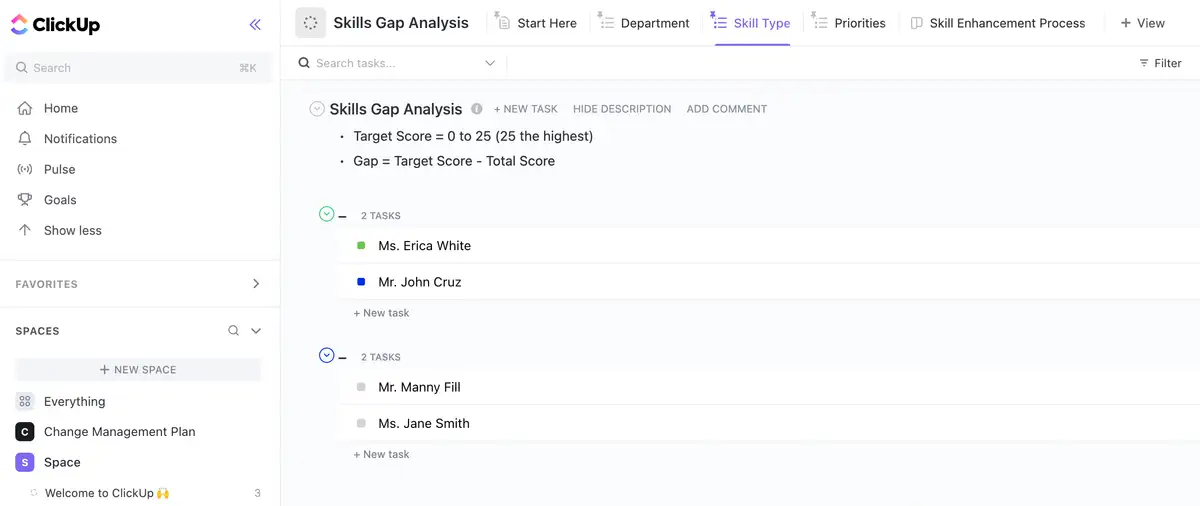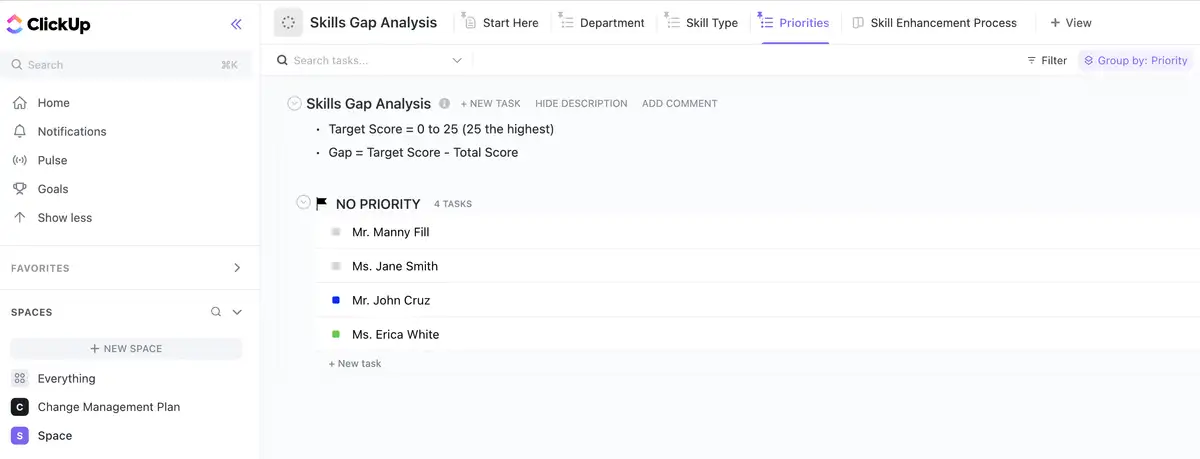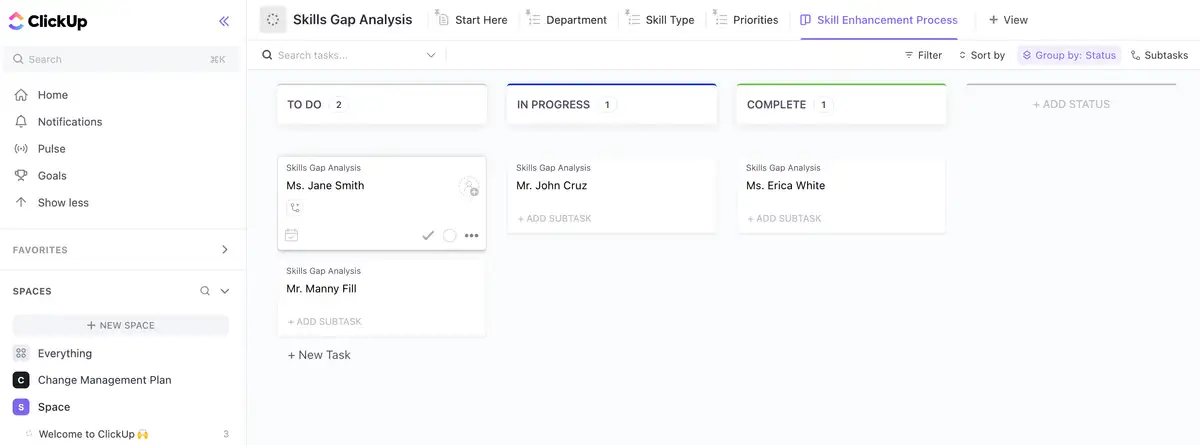Do you find that the employees in your organization have the knowledge and experience to get the job done, but they're missing some key skills necessary to gain a competitive edge? It could be hindering productivity and preventing your business from reaching its full potential. Don't worry—you're not alone!
More and more organizations are facing the challenges of a constantly changing marketplace that often requires specialized skills. But with some smart strategies for managing talent within an organization, it's possible to create an environment where everyone can thrive and reach their ultimate business goals. So if you’re looking for actionable advice on bridging the skills gap between teams or employees within your organization, ClickUp's skills gap analysis template is for you!
What is a skills gap?
A skills gap is the difference between the current knowledge, experience and abilities of employees within an organization and what is needed to meet business objectives. It can be a result of needed changes in technology or industry trends. When this gap exists, it can cause decreased productivity and limit the ability of an organization to reach its full potential.
For organizations to remain competitive, they must identify and close any existing gaps in skill sets to ensure the best possible performance. This can be achieved through running a skill gap analysis to most effectively execute comprehensive workforce planning strategies, employee training programs, or external recruitment. By addressing and managing any skills gap, organizations can create agile teams that are ready for anything.
How to identify a skills gap
Skills gap analyses can be done by evaluating the current abilities and performance of each employee in an organization. This should include reviewing their qualifications, experience, knowledge and existing training. It's also important to consider upcoming trends in the industry or technology advances that may require new or additional skills for teams to stay competitive.
Once you've identified any discrepancies or gaps, you can create a plan to address and close them. This could include upskilling existing staff, recruiting externally for specialized roles, or implementing new strategies for workforce planning. With the right strategies in place, organizations can start to effectively manage their skills gap and ensure everyone is working towards the same goals.
Common causes of skills gaps
There are a host of reasons you may be experiencing a skill gap—and often many are at play at once. Check out these common causes for skills gaps and see if any apply to your organization:
Changes in technology or industry trends
A lack of training and employee development opportunities
Misalignment between current staff skills and required business objectives
Lacking the right recruitment processes
Poor retention of key talent and personnel turnover
Failing to anticipate or prepare for upcoming skill needs
Inadequate communication between management and staff regarding skills requirements
Not having the right resources to identify or address existing gaps
Insufficient budget for additional training programs or recruitment efforts
Shortage of qualified personnel in the local job market
Weak internal culture that fails to encourage learning and continuous professional development
Poor organizational management of skills gaps or not addressing them at all
Not actively seeking out external sources of talent when needed
Failing to embrace flexible work environments that allow employees to contribute in new ways
Overlooking the potential for leveraging technology to bridge any skills gaps
Not recognizing or taking full advantage of the skills and talent within the organization
Lack of clear career paths for employees to progress into more specialized roles
Poor succession planning or not investing in future skills required by the business
Underestimating the importance of upskilling existing staff when recruiting externally
Not recognizing or nurturing the development of soft skills such as leadership, communication or problem-solving
Not taking into account the cultural differences between employees from diverse backgrounds and experiences
Failing to assess employee performance against industry standards or job descriptions accurately
The benefits of skills gap analysis
Skills gaps leave many organizations flatfooted when trying to achieve their goals. That's why a deeper understanding of your current talent and future needs are key. Here are just some of the benefits to your organization when you conduct a skills gap analysis:
Improved productivity and efficiency
Increased employee morale and engagement
Enhanced customer service
More profitable operations due to better resource allocation
Greater organizational agility and ability to respond quickly to changing market conditions
Improved organizational culture that encourages learning and growth
Ability to recruit top talent from both internal and external sources
More effective use of technology to bridge existing gaps
Increased ability to retain key personnel and reduce turnover
Enhanced organizational competitiveness due to better alignment between current skillset and future needs.
Improved succession planning that allows for the development of future leadership roles.
Ability to develop a strong talent pipeline that can be used to fill specialized roles.
Increased ability to embrace flexible working environments and better utilization of personnel resources.
Improved customer satisfaction due to higher quality output from employees.
Reduced risk associated with technological changes or industry trends.
Enhanced corporate image in the eyes of both customers and potential recruits

Pictured: Skill type seen in List view in ClickUp's skills gap analysis template.
What are the consequences of the skills gap?
The consequences of a skills gap can be far-reaching, impacting the productivity and profitability of an organization as well as its long-term prospects. When an organization is understaffed or lacks the necessary skills to meet current and future requirements, it can lead to decreased performance, reduced customer satisfaction and higher levels of employee dissatisfaction. This can also have a negative impact on the organizational culture, as employees may become frustrated by their lack of skills and knowledge.
In addition to these direct consequences, an organization with a significant skills gap can also suffer from an inability to compete in the marketplace and stay ahead of industry trends or technological advancement. This can lead to difficulty in recruiting high-level personnel externally, as well as retaining key talent internally. It can also mean that the organization is unable to take advantage of new opportunities which may arise due to changes in market conditions or other external factors.
Ultimately, a skills gap, if left unchecked, can adversely affect an organization's bottom line and its ability to reach its full potential. Therefore, it's an essential HR goal to identify skills gaps and manage them within their organization, in order to ensure that teams are equipped with the right knowledge and abilities to achieve success.

Pictured: Skills gap priorities seen in List view in ClickUp's skills gap analysis template.
How can businesses implement a skills gap analysis plan?
Skills gap analysis can require a lot of effort, so it helps to follow these steps as you implement your plan:
- Evaluate current skillsets.
Start by assessing the abilities and performance of each employee in the organization, including their qualifications, experience, knowledge and existing training. Consider upcoming trends in the industry or technology advances that may require new or additional skills.
Create custom fields in ClickUp to track existing skills
in your talent pool.
- Identify gaps.
Measure the skills in your current talent pool against the ones you need to meet your goals. Once you’ve identified any discrepancies or gaps in the current skillsets, create a plan to address and close them.
Use Dashboards in ClickUpto measure your skills gaps
at a glance.
- Create strategies.
Develop effective workforce planning strategies, upskill existing personnel, or recruit externally for specialized roles with specific goals in mind.
Automate tasks in ClickUp to seamlessly put your strategies into action
once you've developed them.
- Implement changes.
Ensure that any changes to recruitment processes or training are well communicated to staff and that they are given the resources and support to develop new skills.
Assign tasks in ClickUp for training and skill development
to keep your people on track.
- Monitor progress.
Regularly evaluate the effectiveness of your strategies by monitoring employee performance reviews and adjusting plans as necessary.
Use custom fields in ClickUp to track training completion rates.
- Embrace technology.
Leverage technology to bridge any gaps, such as using online learning platforms or AI-powered tools to identify talent.
Use ClickUp to assign required learning modules
to employees.
- Recognize and reward.
Make sure you recognize and reward employees for mastering new skills or taking on additional responsibilities, as this will help incentivize further learning and growth.

Pictured: Skill enhancement process seen in Board view in ClickUp's skills gap analysis template.
By following these steps, businesses can successfully manage any gaps in their workforce and create an environment where everyone has the opportunity to reach their full potential. With the right strategies in place, organizations can start to effectively manage their skills gap and ensure everyone is working towards the same goals.
Skills gap analysis and management best practices?
Effectively performing a skills gap analysis can be tough, but these tried-and-true tips can help you achieve success:
Set clear objectives and create a plan to achieve them
Identify existing skill gaps in the organization
Assess employee performance against industry standards or job descriptions accurately
Recruit externally for specialized roles when necessary
Leverage HR software to bridge any gaps
Recognize and reward employees for mastering new skills or taking on additional responsibilities
Develop a strong talent pipeline that can be used to fill specialized roles
Embrace flexible work environments that allow employees to contribute in new ways
Foster an organizational culture that encourages learning and development
Create succession plans to ensure the development of future leadership roles
Monitor and adjust strategies as necessary to ensure objectives are achieved.
Following these best practices for skills gap management and analysis can help ensure that your teams remain agile and competitive in a constantly changing marketplace. With some smart strategies for managing talent within an organization, it's possible to create an environment where everyone can thrive and reach their ultimate business goals.
Common challenges with skills gap analysis and management.
Skills gap analysis and management can be a challenging task for any organization, as it requires careful planning and execution to ensure that the right personnel with the necessary skillsets are in place. Common challenges include a lack of training opportunities, insufficient training budget for additional programs or recruitment efforts, poor retention of key talent and inadequate communication between management and staff regarding skills requirements. Additionally, there can be a shortage of qualified personnel in the local job market and not enough resources to identify or address existing gaps.
Furthermore, it can sometimes be difficult for organizations to embrace flexible work environments that allow employees to contribute in new ways or leverage technology to bridge any gaps. It's also important to recognize and nurture the development of soft skills such as leadership, communication or problem-solving. Finally, not having clear career paths for employees to progress into more specialized roles can be another challenge with skills gap management.
To overcome these challenges, organizations must have the right strategies in place to identify any existing gaps in skill sets, and then close them through effective workforce planning strategies, upskilling existing personnel, or recruiting externally with specific goals in mind. By addressing and managing any skill gaps, organizations can create agile teams that are ready for anything.
Key takeaways
Analyzing skill gaps is an important and challenging task for any organization. By assessing the current abilities and performance of each employee, identifying discrepancies or gaps, creating strategies to address them, implementing changes, and monitoring progress regularly, organizations can start to effectively manage their skills gap.
By using ClickUp's skills gap analysis template, you can help ensure that your teams remain agile and competitive in a constantly changing marketplace. Good luck!







